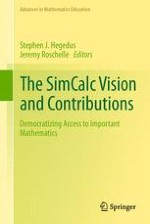2013 | OriginalPaper | Buchkapitel
SimCalc and the Networked Classroom
verfasst von : Corey Brady, Tobin White, Sarah Davis, Stephen Hegedus
Erschienen in: The SimCalc Vision and Contributions
Verlag: Springer Netherlands
Aktivieren Sie unsere intelligente Suche, um passende Fachinhalte oder Patente zu finden.
Wählen Sie Textabschnitte aus um mit Künstlicher Intelligenz passenden Patente zu finden. powered by
Markieren Sie Textabschnitte, um KI-gestützt weitere passende Inhalte zu finden. powered by
